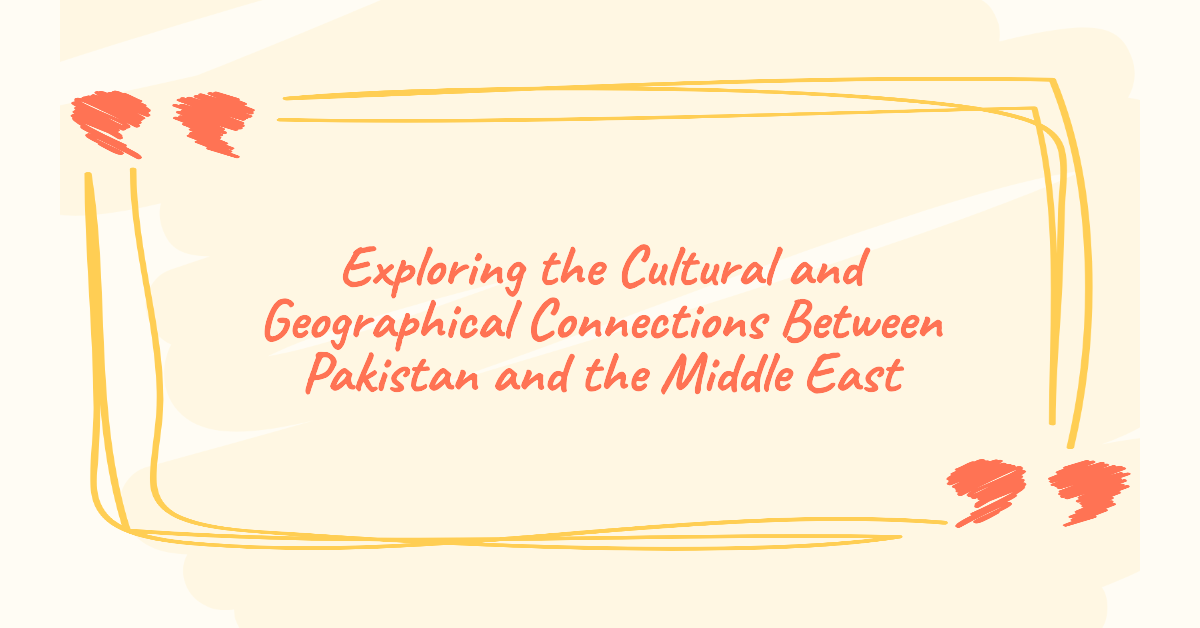Imagine a bustling country with a rich cultural heritage, a fusion of traditions, and a land that has been home to countless civilizations. That country is Pakistan. But have you ever wondered if Pakistanis are considered Middle Eastern? This article aims to shed light on this intriguing question, exploring the geographical and cultural aspects that define Pakistan’s identity and its unique position in the world. Prepare to uncover the truth about Pakistan’s connection to the Middle East.
Geographical Location of Pakistan
Pakistan is located in South Asia and is known as a South Asian country. It shares its borders with several countries, including Afghanistan and Iran to the west, India to the east, and China to the north. With its diverse terrain, Pakistan is blessed with natural beauty, ranging from the peaks of the Himalayas in the north to the vast deserts of Thar in the south. The country is also home to the fertile plains of the Indus River, which have facilitated the development of sophisticated irrigation systems.
Middle East vs. South Asia
Middle East
The Middle East, on the other hand, is a region that lies at the crossroads of three continents: Asia, Africa, and Europe. It is primarily characterized by countries such as Saudi Arabia, Kuwait, Egypt, and Iraq. The Middle East is known for its rich cultural heritage, vibrant cities, and vast reserves of oil and natural gas.
South Asia
South Asia, on the other hand, encompasses countries like India, Bangladesh, Sri Lanka, and Pakistan. This region stands out for its historical and cultural diversity, as well as its immense population. Major world religions such as Hinduism and Buddhism originated in South Asia, making it a significant center for spirituality.
Differences
While both the Middle East and South Asia are geographically close to each other and share some cultural similarities, they have distinct characteristics that differentiate them. The Middle East is predominantly Arab and has a stronger Islamic influence, while South Asia is home to various ethnicities and religions, including Islam, Hinduism, Buddhism, and Sikhism. Additionally, the Middle East and South Asia have different historical, political, and economic contexts that shape their respective identities.
Ethnicity and Linguistics
Pakistani Ethnicity
Pakistan is a diverse country with a rich mix of ethnic groups. The largest ethnic group in Pakistan is the Punjabi, followed by the Pashtun, Sindhi, Baloch, and Muhajir communities. Each ethnic group contributes to the cultural and linguistic diversity of the country, adding to its vibrant tapestry.
Languages Spoken
Pakistan is a linguistically diverse country with several languages spoken throughout its various regions. Urdu is the national language and serves as the lingua franca of the country. However, other regional languages like Punjabi, Pashto, Sindhi, Balochi, and Saraiki are widely spoken by their respective communities. This linguistic diversity reflects the rich cultural heritage and historical connections of Pakistan’s diverse ethnic groups.
Historical Connections with the Middle East
Islamic Influence
Pakistan has strong historical ties with the Middle East, primarily due to its Islamic heritage. Islam arrived in South Asia with the Arab conquests during the 7th and 8th centuries. The spread of Islam in the region led to the establishment of powerful Muslim empires, including the Delhi Sultanate and the Mughal Empire. These empires had close connections with the Middle East, both culturally and economically.
Colonial Era
During the colonial era, Pakistan was a part of British India. The British influence in the region brought about significant political, social, and economic changes. However, the colonial period also marked the decline of the Islamic empires and the rise of nationalist movements, ultimately leading to the partition of India and the creation of Pakistan as a separate nation in 1947.
Migration Patterns
Throughout history, Pakistan has witnessed migration patterns that have deepened its connections with the Middle East. Many Pakistanis have migrated to countries like Saudi Arabia, the United Arab Emirates, and Qatar in search of better economic opportunities. This has created strong economic ties and cultural exchanges between Pakistan and Middle Eastern countries.
Religious Aspects
Islam in Pakistan
Islam is the dominant religion in Pakistan, with a majority of its population identifying as Muslims. The country was founded as a homeland for Muslims, and Islamic principles form the foundation of its legal and social frameworks. Mosques and Islamic institutions are an integral part of Pakistan’s landscape, providing spiritual guidance and religious education to its people.
Similarities with Middle Eastern Countries
Pakistan shares many similarities with Middle Eastern countries in terms of Islamic practices and traditions. Halal food, for example, is widely consumed in both regions, and the significance of prayer and pilgrimage in Islam is deeply ingrained in the cultural fabric of Pakistan. Additionally, Pakistanis often look to Middle Eastern countries, such as Saudi Arabia, as centers of Islamic learning and pilgrimage.
Diverse Religious Landscape
While Islam is the predominant religion in Pakistan, the country also has a diverse religious landscape. Minority groups such as Hindus, Christians, Sikhs, and Buddhists coexist with Muslims, contributing to the multicultural tapestry of the nation. Pakistan’s constitution guarantees religious freedom and protection for these minority communities, fostering an environment of religious tolerance and diversity.
Cultural Similarities and Differences
Cultural Influences
Pakistan’s cultural landscape is a fusion of various influences, including Central Asian, Persian, and Arab cultures. These influences are evident in architecture, music, dance, literature, and clothing. The Middle Eastern influence can be seen in Pakistan’s traditional clothing styles, such as the shalwar kameez, which resembles the traditional attire of Arab countries.
Traditions and Customs
Pakistan shares various traditions and customs with Middle Eastern countries, such as hospitality, respect for elders, and the importance of family. Both regions place a strong emphasis on communal celebrations, where families and communities come together to mark important occasions.
Celebrations and Festivals
Pakistan has a rich tradition of celebrating religious and cultural festivals. Eid-ul-Fitr and Eid-ul-Adha, two important Islamic festivals, are celebrated with enthusiasm and grandeur across the country. Similarly, Pakistan’s cultural festivals, such as Basant, celebrate the arrival of spring with vibrant kite-flying competitions and music performances. These festivals reflect the diverse cultural heritage of Pakistan and its connection to both the Middle East and South Asia.
Political Relations
Bilateral Relations
Pakistan has had deep-rooted political relations with Middle Eastern countries. These relations have been forged through historical, economic, and cultural ties. Pakistan maintains close bilateral relations with countries like Saudi Arabia, the United Arab Emirates, and Iran, with diplomatic engagements and collaborations in various fields.
Trade and Economic Cooperation
Trade and economic cooperation form a crucial aspect of Pakistan’s political relations with the Middle East. Pakistan exports goods such as textiles, rice, and fruits to Middle Eastern countries, while also importing oil, petroleum products, and machinery. The exchange of goods and services contributes to the economic growth and stability of both regions.
Diplomatic Relations
Diplomatic relations between Pakistan and Middle Eastern nations are characterized by mutual cooperation and support. Pakistan has played a significant role in mediating conflicts in the Middle East, including facilitating peace talks between Arab countries and serving as a strategic ally in regional security initiatives. These diplomatic ties underscore the importance of Pakistan’s relationship with the Middle East.
International Perspective
Pakistan’s Role in the Middle East
Pakistan’s strategic location and historical connections with the Middle East make it an important player in regional affairs. Pakistan has actively contributed to peacekeeping efforts in the Middle East, specifically in countries like Saudi Arabia and Iraq. Additionally, Pakistan has been involved in resolving conflicts and promoting stability in the region, highlighting its commitment to maintaining peace and fostering strong international relations.
Perceptions of Middle Eastern Identity
Although Pakistan geographically falls within South Asia, its Islamic and cultural similarities with the Middle East have sometimes led to perceptions of it being part of the region. This perception varies among individuals and may depend on factors such as personal experiences, historical knowledge, and cultural understanding. Ultimately, Pakistan’s identity lies at the intersection of South Asia and the Middle East, embodying the unique characteristics of both regions.
Pakistan’s Role in South Asia
Role as a South Asian Country
As a South Asian country, Pakistan plays a crucial role in the region. It is one of the largest countries in South Asia and has a significant population, contributing to the cultural, economic, and political dynamics of the region. Pakistan’s geographical location also positions it as a gateway between South Asia and Central Asia, further enhancing its regional significance.
Regional Organizations
Pakistan actively participates in regional organizations such as the South Asian Association for Regional Cooperation (SAARC), which aims to promote regional cooperation and economic integration in South Asia. Through its engagement in SAARC and other regional initiatives, Pakistan works towards enhancing regional stability, trade, and cultural exchanges among South Asian countries.
Collaboration with South Asian Nations
Pakistan maintains diplomatic relations and collaborates with South Asian nations on various fronts, including trade, security, and cultural exchanges. Initiatives such as the South Asian Free Trade Agreement (SAFTA) and the South Asian University (SAU) foster economic cooperation and academic exchanges within the region. These collaborations further establish Pakistan’s role as an active participant in South Asia.
Conclusion
In conclusion, Pakistan’s geographical location, historical connections, and cultural diversity make it a unique bridge between the Middle East and South Asia. While Pakistan is officially classified as a South Asian country, it shares various cultural, linguistic, and religious similarities with the Middle East. The country’s Islamic heritage, colonial history, and migration patterns have deepened its ties with the Middle East, fostering shared traditions and customs. Simultaneously, Pakistan actively contributes to South Asian regional initiatives and plays a pivotal role in promoting stability, cooperation, and integration within the region. As a result, Pakistan occupies a distinct position, embodying the cultural, political, and economic characteristics of both the Middle East and South Asia.
I'm an SEO copywriter and blogger whose goal is to help fellow Pakistanis start their own online businesses. I've been doing freelance writing and SEO for about 4 years now.


